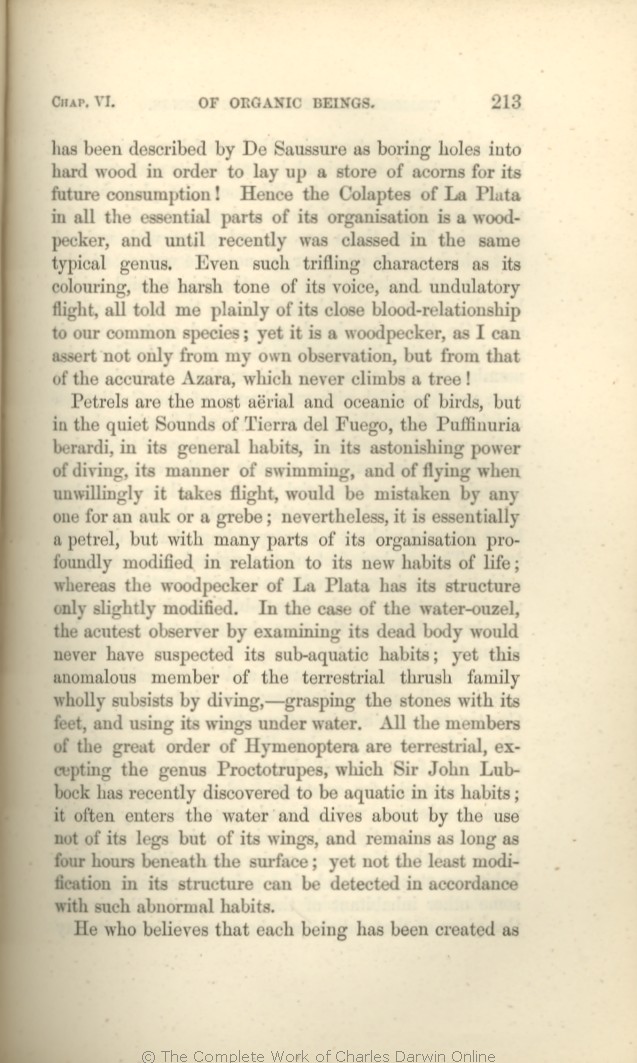been | been 1861 1866 | been 1869 1872 |
| described 1861 1866 | described 1869 1872 |
| Saussure 1861 1866 | Saussure 1869 1872 |
| boring 1861 1866 | boring 1869 1872 |
| holes 1861 1866 | holes 1869 1872 |
| into 1861 1866 | into 1869 1872 |
| hard 1861 1866 | hard 1869 1872 |
| wood 1861 1866 | wood 1869 1872 |
| order 1861 1866 | order 1869 1872 |
| lay 1861 1866 | lay 1869 1872 |
| store 1861 1866 | store 1869 1872 |
| acorns 1861 1866 | acorns 1869 1872 |
| for 1861 1866 | for 1869 1872 |
| its 1861 1866 | its 1869 1872 |
| future 1861 1866 | future 1869 1872 |
| consumption! 1861 1866 | consumption! 1869 1872 |
| the 1861 1866 | | this 1869 1872 |
| of La Plata 1861 1866 |
| OMIT 1869 1872 |
| organisation 1866 | | organization 1861 | | structure 1869 1872 |
| woodpecker, 1861 1866 | | woodpecker. 1869 1872 |
| and 1861 1866 | and 1869 1872 |
| until 1861 1866 | until 1869 1872 |
| recently 1861 1866 | recently 1869 1872 |
| was 1861 1866 | was 1869 1872 |
| classed 1861 1866 | classed 1869 1872 |
| the 1861 1866 | the 1869 1872 |
| same 1861 1866 | same 1869 1872 |
| typical 1861 1866 | typical 1869 1872 |
| genus. 1861 1866 | genus. 1869 1872 |
| such 1861 1866 | | in such 1869 1872 |
| its 1861 1866 | | the 1869 1872 |
| its 1861 1866 | | the 1869 1872 |
| all told me plainly of 1861 1866 |
| all plainly declared 1869 |
| OMIT 1872 |
| species; yet it is a woodpecker, 1861 1866 |
| woodpecker; yet, 1869 |
| woodpecker is plainly declared; yet, 1872 |
| assert 1861 1866 | | assert, 1869 1872 |
| observation, 1861 1866 1869 | | observations, 1872 |
| that 1861 1866 1869 | | those 1872 |
| which never climbs a tree! 1861 1866 |
| it never climbs a tree! I may mention as another illustration of the varied habits of the tribe, that a Mexican Colaptes has been described by De Saussure as boring holes into hard wood in order to lay up a store of acorns, but for what use is not yet known. 1869 |
| in certain large districts it does not climb trees, and it makes its nest in holes in banks! 1872 |
| 2 blocks not present in 1859 1860 1861 1866 1869; present in 1872 | | In certain other districts, however, this same woodpecker, as Mr. Hudson states, frequents trees, and bores holes in the trunk for its nest.
I may mention as another illustration of the varied habits of this genus, that a Mexican Colaptes has been described by De Saussure as boring holes into hard wood in order to lay up a store of acorns.
|
|
|
Petrels are the most
aërial | aërial 1866 1869 | | aërial 1859 1860 1861 1872 |
| but 1861 1866 1869 1872 | | yet 1859 1860 |
| Sounds 1859 1860 1861 1866 | | sounds 1869 1872 |
| its 1859 1860 1861 1866 1869 | | in its 1872 |
| swimming, 1859 1860 1861 1866 1869 | | swimming 1872 |
| unwillingly it 1859 1860 1861 1866 | | made to 1869 1872 |
| takes 1859 1860 1861 1866 | | take 1869 1872 |
| a grebe; 1861 1866 1869 1872 | | grebe; 1859 1860 |
| nevertheless, 1859 1860 1861 1866 | | nevertheless 1869 1872 |
| modified in relation to its new habits of life; whereas the woodpecker of La Plata has its structure only slightly modified. 1861 1866 |
| modified. 1859 1860 |
| modified in relation to its new habits of life; whereas the woodpecker of La Plata has had its structure only slightly modified. 1869 1872 |
| anomalous member of the terrestrial 1866 |
| bird, which is allied to the 1869 1872 |
| family 1866 | | family, 1869 1872 |
| wholly 1866 1869 | wholly 1872 |
| diving,—grasping the stones with its feet, and 1866 |
| diving—using its wings under water, and grasping stones with its feet. 1869 |
| diving— 1872 |
| using 1866 1872 | using 1869 |
| wings 1866 1872 | wings 1869 |
| under 1866 1872 | under 1869 |
| water. 1866 |
| water, and grasping stones with its feet. 1872 |
| OMIT 1869 |
| Hymenoptera 1866 | | Hymenopterous 1869 1872 |
| are 1866 | | insects are 1869 1872 |
| recently 1866 1869 | recently 1872 |
| not the least 1866 1869 |
| it exhibits no 1872 |
| can be detected 1866 1869 |
| OMIT 1872 |
| 1 blocks not present in 1866 1869 1872; present in 1859 1860 1861 | | On
the other hand,
the acutest observer by examining the
dead body of the water-ouzel
would never have suspected its sub-aquatic habits; yet this anomalous member of the strictly
terrestrial thrush family wholly subsists by diving,— grasping the stones with its feet
and using its wings under water.
|
|
|
| He who believes that each being has been created as
|









